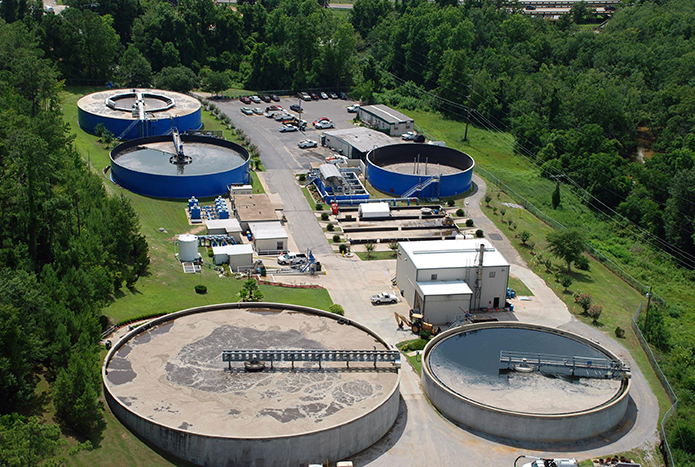At Daphne Utilities, our top priority is to provide a reliable wastewater collection and treatment system that supports the needs of our community, protects the environment and quality of life for all Eastern Shore residents, and meets or surpasses all federal and state requirements.
Daphne Utilities wastewater system includes two components: the collection system and the treatment process. The wastewater collection and treatment process is a 24-hour-per-day, 7 day-a-week responsibility and we have a highly-trained, state-certified staff who perform an excellent job with both.
WASTEWATER COLLECTION SYSTEM
The network of pipes that comprise the wastewater collection system include over 160 miles of gravity pipe, 30 miles of force mains, and 20 miles of low-pressure mains ranging in size from 2” to 24” in diameter. The system receives flow from more than 12,000 customers and is pumped via 81 pump stations and pressure pipelines to the Water Reclamation Facility for treatment before being returned to Blakeley River at the head of Mobile Bay. The system of pipelines and pump stations collects and transports approximately 3 million gallons of wastewater every day from homes and businesses all along the Eastern Shore.
Throughout the year, we regularly maintain and inspect the wastewater collection system to identify and repair defects before problems occur and to help reduce the chance of sewer overflows. Unfortunately, grease and other debris stick inside of the sewer lines and create blockages leading to overflows. Our crews perform predictive and preventative maintenance on our pipelines to reduce the likelihood of blockages occurring. Our goal is to reduce the number of collection system overflows to ZERO, so we work hard to protect our system from issues which lead to blockages and overflows. The following is an overview of some of the ways we do that:
I/I Investigations:
Inflow and Infiltration (I/I) is extraneous water that gets into the wastewater collection system – basically any water other than sewage. We conduct an extensive investigation program throughout the year that includes smoke testing, closed-circuit video inspection, and flow monitoring. These assist us in determining areas where storm water can enter the collection system. Once we have located problems areas, we take steps to remediate the problem.
Routine Pipe Cleaning:
Each month we routinely clean an average of more than 3,000 linear feet of pipe with special high pressure equipment designed to remove grease and other debris from the system. We also inspected 40 manholes on average each month. This routine cleaning and inspection program further reduces the potential for system blockages and overflow.
Priority Cleaning:
Portions of the wastewater collection system are more problematic than others and require more frequent cleaning. These portions of the system are cleaned a minimum of once annually to prevent blockages and overflows.
Pre-Treatment / Grease Management Program:
Besides the fats, oils, and grease (FOG) entering the collection system from residential homes, commercial food service establishments can also contribute to residual FOG in the collection system as a byproduct of cooking and kitchen cleaning. As a result, all food service establishments are required to have a grease interceptor device installed to minimize the amount of FOG entering the collection system. In addition, commercial customers that service or wash automobiles are required to have sand/oil interceptors. These devices help protect the wastewater collection system by removing sediment, oil, grease, and other petroleum products from the customer’s wastewater discharge. Daphne Utilities’ personnel inspect these interceptors throughout the year to ensure they are working properly. Education in “best management practices” is also regularly conducted with facility managers.
WATER RECLAMATION FACILITY
Once relegated to the title of "sewage plants," state-of-the-art facilities like Daphne Utilities’ are now known as Water Reclamation Facilities. They are so named because today’s wastewater treatment cleans and disinfects the wastewater to a level that is cleaner than the natural environmental waters to which it is returned.
The Daphne Water Reclamation Facility (WRF) is permitted to treat up to 4.17 million gallons of wastewater per day (MGD), but has the hydraulic capacity to process up to 9 MGD. The facility serves approximately 12,000 homes and businesses and treats an average of 3 million gallons of wastewater every day. In 2018, the facility processed more than 1 billion gallons of wastewater.
The facility uses a biological process that removes organic materials and nutrients, such as phosphorus and nitrogen, from the wastewater to ensure treated wastewater is safely returned to local waterways. More than 3 tons per day of organic material is removed before the water is returned to the environment. The WRF discharges exceptionally treated water to Blakeley River located at the head of Mobile Bay just south of the I-10 Bayway.














